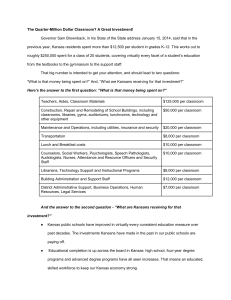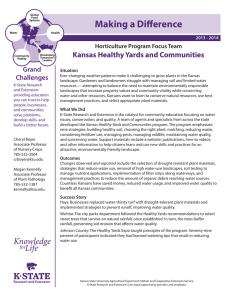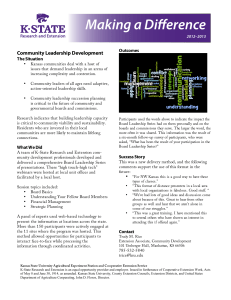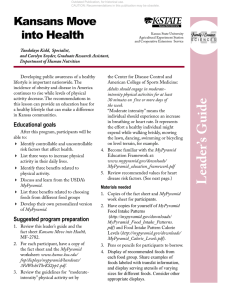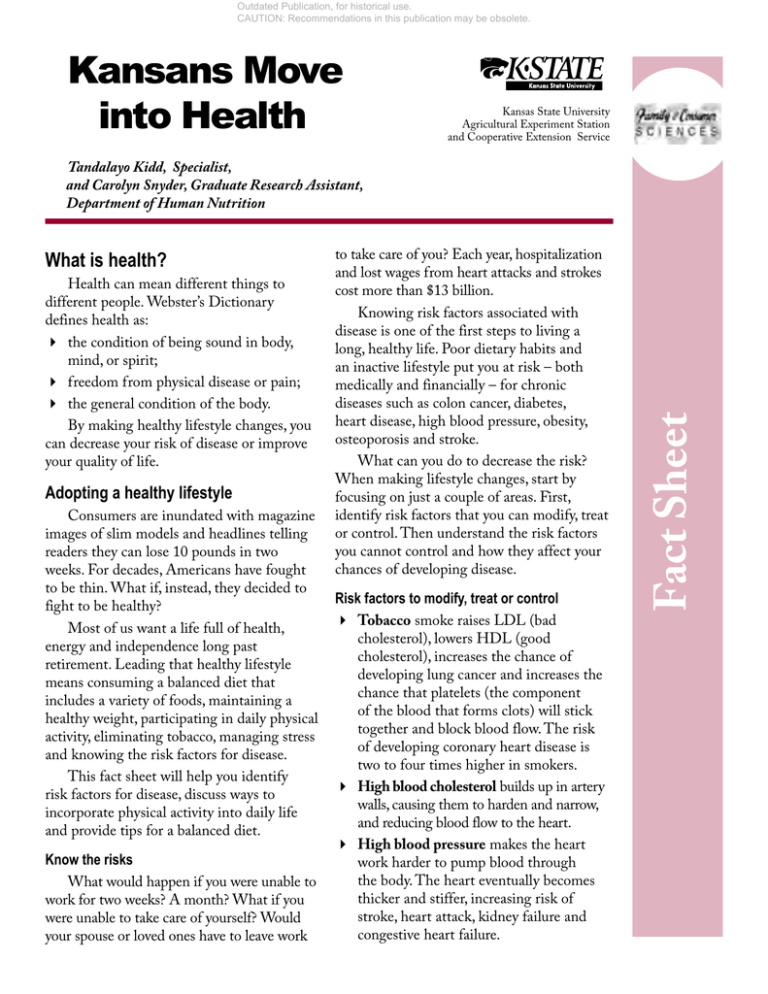
Outdated Publication, for historical use.
CAUTION: Recommendations in this publication may be obsolete.
Kansans Move
into Health
Tandalayo Kidd, Specialist,
and Carolyn Snyder, Graduate Research Assistant,
Department of Human Nutrition
What is health?
Health can mean different things to
different people. Webster’s Dictionary
defines health as:
4the condition of being sound in body,
mind, or spirit;
4freedom from physical disease or pain;
4the general condition of the body.
By making healthy lifestyle changes, you
can decrease your risk of disease or improve
your quality of life.
Adopting a healthy lifestyle
Consumers are inundated with magazine
images of slim models and headlines telling
readers they can lose 10 pounds in two
weeks. For decades, Americans have fought
to be thin. What if, instead, they decided to
fight to be healthy?
Most of us want a life full of health,
energy and independence long past
retirement. Leading that healthy lifestyle
means consuming a balanced diet that
includes a variety of foods, maintaining a
healthy weight, participating in daily physical
activity, eliminating tobacco, managing stress
and knowing the risk factors for disease.
This fact sheet will help you identify
risk factors for disease, discuss ways to
incorporate physical activity into daily life
and provide tips for a balanced diet.
Know the risks
What would happen if you were unable to
work for two weeks? A month? What if you
were unable to take care of yourself? Would
your spouse or loved ones have to leave work
to take care of you? Each year, hospitalization
and lost wages from heart attacks and strokes
cost more than $13 billion.
Knowing risk factors associated with
disease is one of the first steps to living a
long, healthy life. Poor dietary habits and
an inactive lifestyle put you at risk – both
medically and financially – for chronic
diseases such as colon cancer, diabetes,
heart disease, high blood pressure, obesity,
osteoporosis and stroke.
What can you do to decrease the risk?
When making lifestyle changes, start by
focusing on just a couple of areas. First,
identify risk factors that you can modify, treat
or control. Then understand the risk factors
you cannot control and how they affect your
chances of developing disease.
Risk factors to modify, treat or control
4Tobacco smoke raises LDL (bad
cholesterol), lowers HDL (good
cholesterol), increases the chance of
developing lung cancer and increases the
chance that platelets (the component
of the blood that forms clots) will stick
together and block blood flow. The risk
of developing coronary heart disease is
two to four times higher in smokers.
4High blood cholesterol builds up in artery
walls, causing them to harden and narrow,
and reducing blood flow to the heart.
4High blood pressure makes the heart
work harder to pump blood through
the body. The heart eventually becomes
thicker and stiffer, increasing risk of
stroke, heart attack, kidney failure and
congestive heart failure.
Fact Sheet
Kansas State University
Agricultural Experiment Station
and Cooperative Extension Service
Outdated Publication, for historical use.
CAUTION: Recommendations in this publication may be obsolete.
4Physical inactivity is a risk factor for
coronary heart disease and obesity, as well
as osteoporosis, due to lack of weightbearing or strength-training exercise.
4Obesity or being overweight increases
the likelihood of developing heart disease
and stroke, even for those who have
no other risk factors. Excess body fat,
especially around the waist, increases the
heart’s workload.
4Diabetes mellitus increases the risk
of heart disease and stroke. If you have
diabetes, work closely with your healthcare providers and follow their advice to
manage it and control other risk factors.
4Alcohol consumption, in excess, can
raise blood pressure; cause irregular
heartbeat or heart failure; lead to stroke;
and contribute to high triglycerides,
cancer and other diseases. One drink is
defined as 12 ounces of regular beer, 5
ounces of wine, or 1½ ounces of 80-proof
distilled spirits (such as vodka or gin).
4Stress affects the body and mind,
contributing to heart disease, high blood
pressure, obesity, cancer and depression.
Major risk factors that can not be changed
4Advancing age increases the chance of
coronary heart disease. More than 83
percent of people who die of coronary
disease are 65 or older. Bones become
weaker with age, increasing the risk of
osteoporosis.
4Gender is a factor. Men have a greater
risk of heart attack than women, and the
risk occurs earlier in life. Women have a
greater chance of developing osteoporosis
because they have less bone mass.
4Heredity (including race) can increase
risk. Children of parents with heart
disease are more likely to develop it
themselves. African-Americans have
a greater chance of developing high
blood pressure and heart disease than
Caucasians. Heart disease risk is also
higher among Mexican-Americans,
native Americans, native Hawaiians
and some Asian-Americans. Asian and
Caucasian women have a higher risk of
developing osteoporosis.
Since you cannot control your age,
gender, race or family heritage, it is important
to treat and control other risk factors.
Are Kansans moving toward health?
According to Kansas State University’s
Community Health Institute, 78 percent
of adult Kansans are not physically active
on a regular basis. The Centers for Disease
Control and Prevention (CDC) and the
American College of Sports Medicine
(ACSM) set an activity recommendation of
at least 30 minutes of moderate-intensity
activity five or more days a week. Four
out of five adult Kansans fail to meet that
recommendation.
To encourage Kansans to be physically
active, K-State Research and Extension
developed Walk Kansas (www.walkkansas.
org), a science-based program to help
Kansans start and maintain a regular routine
of physical activity. The eight-week walking
program begins each March with family
members, co-workers, friends and neighbors
teaming up to collectively walk the distance
(423 miles) equivalent to walking across the
state. (Contact your local K-State Research
and Extension office for details.)
Increase physical activity
To increase your activity level, you don’t
need to be thin or fit, join a gym or buy
any special equipment. Moderate activity
includes brisk walking, gardening, housework
or playing with children. Those who want to
become more active can make small lifestyle
changes to achieve big results.
4Take the stairs instead of the elevator
or escalator.
4Walk part (or all) of the way to work
or school.
Outdated Publication, for historical use.
CAUTION: Recommendations in this publication may be obsolete.
4Go for a walk on your lunch break.
4Walk to the store.
4Get up and change TV channels without
the remote.
4Park at the edge of the grocery store
parking lot instead of finding the
closest spot.
4Pick up a pedometer to measure the
number of steps you take each day. The
national recommendation is 10,000 steps
a day. If you currently walk 4,000 a day,
work up to 6,000, and keep building.
4Take a 10-minute walk before dinner and
work up to 30 minutes.
Benefits of physical activity
Physical activity leads to a healthier
lifestyle:
4Helping prevent heart disease and stroke.
4Lowering blood pressure; raising the
HDL (good cholesterol) level and
lowering level of LDL (bad cholesterol).
4Reducing body fat.
4Helping to prevent and control
noninsulin-dependent diabetes.
4Building and preserving muscle mass
and improving the body’s ability to
use calories.
4Combined with proper nutrition, helping
to control weight and prevent obesity –
a major risk factor for many diseases.
4Increasing muscle strength and
endurance, and improving flexibility and
posture as ways to help prevent back pain.
4Promoting bone formation and
preventing bone loss associated
with aging.
4Improving mood and self-image.
Researchers have found that exercise is
likely to reduce depression and anxiety,
and may help manage stress.
Move toward change
What are the reasons you are not more
physically active? Write down barriers that
prevent you from being physically active;
then develop a solution to each barrier.
Barriers to Physical Activity
1. 2. 3. Solutions
1. 2. 3. Balance the Diet
Have you noticed that the Food Guide
Pyramid has undergone a makeover? The
new MyPyramid food guidance system
is designed to reflect the 2005 Dietary
Guidelines for Americans. See it at
www.mypyramid.gov.
The pyramid shows that most daily
calories should come from the grain group
(the widest band), followed by vegetables,
milk, fruit, meat and beans, and oils. Each
person’s daily calorie needs differ because of
age, gender and activity level. Improvement
occurs when small steps lead toward the goal.
Outdated Publication, for historical use.
CAUTION: Recommendations in this publication may be obsolete.
Recommendations
As basic tips, MyPyramid recommends:
4make half your grains whole
4vary your veggies
4focus on fruits
4get your calcium-rich foods
4go lean with protein
Whole grains contain the entire grain
kernel – bran, germ and endosperm. This
group includes whole-wheat flour, bulgur,
oatmeal and brown rice. Grains provide B
vitamins, minerals and dietary fiber.
Vegetables are cholesterol-free, and most
are low in fat and calories. They provide fiber;
potassium; vitamins A, E and C; and folate.
Fruits provide some of the same nutrients
as vegetables and some grain products,
but different fruits and vegetables contain
different phytochemicals to help protect the
body against heart disease and certain cancers.
Calcium, from the milk group, helps
build bones and teeth, and maintain bone mass.
Vitamin D helps improve the body’s calcium
absorption and maintenance.
Protein foods can be high in saturated fats
and cholesterol, and can raise the level of LDL
cholesterol. High LDL levels increase the risk
of coronary heart disease, so choices from this
group should be lean or low in fat.
Healthy for a lifetime
Use MyPyramid as a guide to choosing
food and activities. Select foods from each
group to meet your nutritional needs.
Gradually improve food choices and physical
activity levels. Start with small goals and add
new ones as you progress. Stay within your
daily calorie needs, and plan physical activity
for 30 minutes most days of the week.
You may feel better and live longer by
adopting a healthier way of life. You can also
become a positive role model. Regardless
of what you do, personalize active behavior
changes to fit your life as you move into health.
Authors
Tandalayo Kidd, PhD, RD, LPN, Specialist, and
Carolyn Snyder, RD, LD, Graduate Research Assistant,
Department of Human Nutrition, Kansas State University
Resources
American Heart Association. www.americanheart.org
Centers for Disease Control and Prevention. “Physical Activity for Everyone: The Importance of Physical Activity.”
www.cdc.gov/nccdphp/dnpa/physical/importance/index.htm
Kansas State University Community Health Institute. “Healthy Eating and Physical Activity.”
National Osteoporosis Foundation. Prevention: Who’s at Risk? www.nof.org/prevention/risk.htm
Qureshi, AI; Suri, MFK; Kirmani, JF; Divani, AA. (2004). The Relative Impact of Inadequate Primary and Secondary Prevention on
Cardiovascular Mortality in the United States. Stroke, 35: 2346 – 2350.
United States Department of Agriculture. MyPyramid. http://mypyramid.gov/index.html
United States Department of Health and Human Services. “Physical Activity Fundamental to Preventing Disease.”
http://aspe.hhs.gov/health/reports/physicalactivity
Webster’s Dictionary. www.m-w.com/dictionary/health
Brand names appearing in this publication are for product identification purposes only. No endorsement is intended, nor is criticism
implied of similar products not mentioned. Publications from Kansas State University are available on the World Wide Web at:
www.oznet.ksu.edu
Publications from Kansas State University may be freely reproduced for educational purposes. All other rights reserved. In either case,
credit Tandalayo Kidd and Carolyn Snyder, Kansans Move into Health, Kansas State University, July 2007.
Kansas State University Agricultural Experiment Station and Cooperative Extension Service, Manhattan, Kansas
MF-2782
JULY 2007
K-State Research and Extension is an equal opportunity provider and employer. These materials may be available in alternative formats. Issued in furtherance of Cooperative Extension
Work, Acts of May 8 and June 30, 1914, as amended. Kansas State University, County Extension Councils, Extension Districts, and United States Department of Agriculture Cooperating,
Fred A. Cholick, Director.

